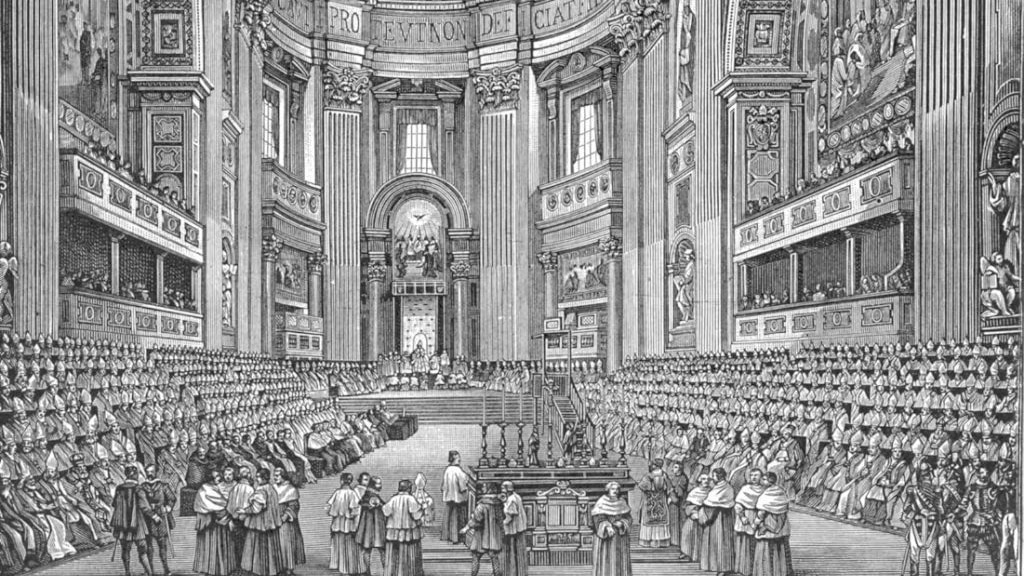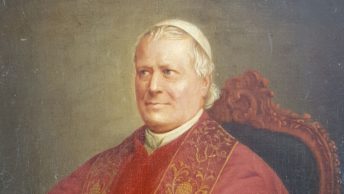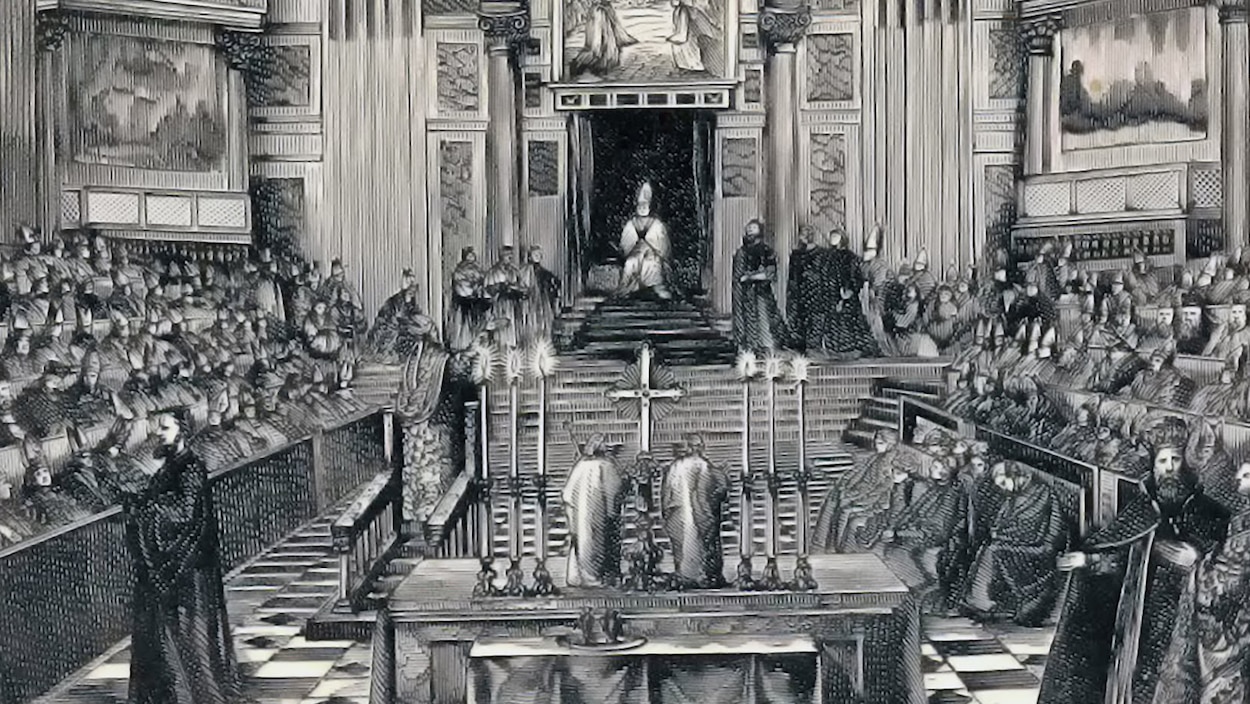Part 1 discussed the origin of the doctrine of Papal Infallibility in the first Vatican Council (1869-1870), as well as relevant documents produced more recently. Part 2 examined the intellectual and spiritual climate at the time of Vatican I, the theological differences of the bishops, the various pressures they felt, and the impact of their deliberations on the Council. Part 3 considers the legacy of Vatican I.
The 150th anniversary of Vatican Council I is approaching, and the time is well suited to consider its far reaching legacy. The Council was a momentous event, having produced an idea that, from that moment to this, has profoundly impacted not only Catholics but people of other faiths and no faith. The idea was that when popes speak on matters of faith and morals, they speak infallibly—that is, without the possibility of error.
The hope of the prelates who supported the new doctrine was that it would reinforce faith in Christ and His Gospel at a time when both were under attack by numerous individuals and philosophies. (There may have been a self-serving motive as well—asserting Roman Catholic primacy among religions—but in all probability it was a secondary one.)
Lamentably, the Council’s legacy has not fulfilled that noble hope. Instead, it has created considerable confusion, notably about who can speak infallibly and who cannot, and what is infallible teaching and what is not. Part 1 of this essay noted the most fundamental confusion in some detail. It may be summarized as follows:
In 1870 Vatican I declared that “Primacy of jurisdiction” was given by Jesus “to Peter alone” among the apostles, and this teaching is “absolutely manifest” by Scripture. Also, that “Whoever succeeds to the chair of Peter” enjoys “full and supreme power of jurisdiction over the whole Church, and this not only in matters of faith and morals, but also in those which concern the discipline and government of the Church.” Finally, whatever definitions the Pope shall make “are of themselves, and not by the consent of the Church, irreformable.”
Almost a century later, in Lumen Gentium, Paul VI reinforced Vatican I and underscored that other bishops “do not enjoy the prerogative of infallibility.”
In 1998, in Ad Tuendam Fidem, John Paul II revised the Profession of Faith to cover not only teachings that are “divinely revealed,” but also “definitively revealed,” a lesser category. Cardinal Ratzinger (later Pope Benedict XVI) then published a commentary supporting John Paul’s revision in these words: “These doctrines are contained in the word of God, written or handed down, and defined with a solemn judgment as divinely revealed truths either by the Roman pontiff when he speaks “ex cathedra” or by the college of bishops gathered in council, or infallibly proposed for belief by the ordinary and universal Magisterium.” (Bold added.)
Ratzinger then declared that when either the pope or the college of bishops “exercise their authentic Magisterium . . . all those teachings on faith and morals presented as true or at least as sure, even if they have not been defined with a solemn judgment or proposed as definitive by the ordinary and universal Magisterium …require religious submission of will and intellect….” (Emphasis his.)
The confusion lies in the fact that the original doctrine of infallibility was changed by John Paul II and the change was ratified by his successor-to-be. Some argue that there was no change, just a “development” or an “elaboration,” but in this context that is a distinction with little if any difference. The present doctrine includes a significant element not present in the original, that added element constitutes a change, and the laity (and, for that matter, the clergy and many bishops) are left wondering whether the infallibility of the original transferred to the revision. To say both are infallible would violate the understanding that to be infallible is to be unchangeable.
Closer examination of the doctrine of infallibiliy, moreover, reveals confusion within the confusion. Before I proceed, however, I want to make clear why I am focusing on confusion.
My intention is not to challenge the doctrine of infallibility, but to point out its need for clarification. The hierarchy have historically emphasized the requirement of all Catholics to give unqualified assent of “will and intellect,” mind and heart, to the truths of the Catholic faith. Such assent, I submit, cannot be given meaningfully without clear and thorough understanding of what is being assented to. Removing the impediment of honest confusion is necessary for that understanding.
To return to the matter of confusion, Vatican Council I resulted in the decree that the Pope can speak infallibly without the bishops’ consent. But wait! If the Council’s consent was not needed for the Pope to speak infallibly, what was the point in bishops traveling from the far corners of the globe to say so? Why didn’t the Pope simply proclaim his power to speak infallibly? On the other hand, if the infallibility doctrine would not have been valid without the Council’s approval, why did the formal statement of the doctrine say the pope’s definitions “are of themselves, and not by the consent of the Church, irreformable”?
At this point, readers may understandably be thinking, “that’s quite enough confusion for one doctrine.” Unfortunately, however, there is more.
Today, the statements that Catholics are required to accept go far beyond the papal ex cathedra statements specified in Vatican I. The Church now recognizes three kinds of Magisterial statements “(1) Infallible dogma, (2) definitive statements on matters closely connected with revealed truth, [and ](3) ordinary teaching on faith and morals.” (A fourth kind was proposed by Avery Dulles but not universally accepted.)
Furthermore, the matters now considered infallible are not only those of “solemn judgment,” but those revealed by the Church’s “ordinary and universal Magisterium” as well. This not only seems to extend infallibility beyond the papal office to the bishops. It actually does so, as is confirmed in The Ordinary and Universal Magisterium (1959), a manual of dogmatic theology: “Bishops spread throughout the world, but with the Roman Pontiff forming one Corporate Body, are infallible when declaring a teaching on faith or morals.” (See also Catechism, 100.)
What is more, the second kind of statements, “definitive [Magisterial] statements,” as distinguished from ex cathedra statements, are also to be regarded as infallible because they are “necessarily connected to divine revelation” and to be so joined “is to be infallible.” (The author cites John Paul II and others in support of this reasoning.) Given Vatican I’s stipulation that statements can be infallible only if ex cathedra, how is it possible for “definitive statements,” which do not meet that standard, to also be infallible? And why didn’t Vatican I mention this in the doctrine of papal infallibility? (Incidentally, if the new formulation was not considered at the time, it must therefore be considered a change in the doctrine.)
Even after several or more readings of all the above material, virtually everyone without a graduate degree in theology, and perhaps more than a few withthat degree, will understand the infallibility doctrine in this way:
First the Church taught that the Pope alone, when speaking ex cathedra, spoke infallibly. Now the Church teaches that the Pope can also speak infallibly when not speaking ex cathedra, and so can other members of the Magisterium! Moreover, the laity are not free to question, let alone doubt, any statements of either kind. In fact, even when the statements have no connection to infallibility but constitute “ordinary teaching on faith and morals,” the laity must give their assent of “mind and will.”
On reaching this understanding, many lay people will wonder, “If all the categories end by saying the same thing—the laity MUST believe what the Church says—why doesn’t the Church save ink and just say, ‘Leave your mind at the Church door, and obey?’” A cynical reaction, to be sure, but given the mystification of Church teaching in these matters, an understandable one, and that is troubling.
Let us turn from the question of who can speak infallibly and who cannot to the question of what is infallible teaching and what is not.
From 1870 until 1950, only a single Roman Catholic teaching was recognized as infallible—the Immaculate Conception of Mary—and that classification was made retroactively. (It was established in 1854, twenty-six years before papal infallibility was declared.) Then in 1950 another teaching was declared infallible—the bodily Assumption of Mary into heaven.
To date, by most accounts, no additional infallible teachings have been added.
At this point, more confusion arises. At least two other teachings are now considered infallible by reliable sources. About contraception an EWTN author offers this comment: “There is no formal declaration, no extraordinary act, but it is certainly infallibly taught from the beginning of the Church, to Paul VI, to today.” (It would seem that the author read the same explanation I did about the three kinds of Magisterial statements—see above—and conflated the second with the first, an understandable reaction considering the confusion of the matter.)
The other teaching now alleged to be infallible concerns the exclusion of women from the priesthood. When Australian bishop William Morris suggested the Church be “more open” to the possibility of ordaining women, Pope Benedict XVI removed him from office. In the letter announcing this decision, Benedict reportedly told Morris that John Paul II had formally (i.e., infallibly) defined the prohibition of women from the priesthood in Ordinatio Sacerdotalis and the matter was therefore not open to discussion, let alone revision. (See also the New York Times report.)
So how many infallible doctrines are there for Catholics to embrace fully and unquestioningly? Two? Three? Four? How can Catholics be sure that at this very moment some line of thought they are honestly pursuing about an issue of faith will not soon fall into the category of forbidden? The confusion about these matters is no doubt of little interest to lax or casual Catholics, but to serious practicing Catholics (especially those tending toward scrupulosity) it is serious indeed.
One final element of confusion, in a way more significant than all the others, concerns the issue of whether the doctrine of infallibility meets the conditions of validity set forth in Catholic Dogmatic Theology. The manual, cited earlier, cites four components of the ordinary and universal Magisterium of the Church: “1) The preaching and proclamations of the Corporate Body of Bishops, 2) universal custom or practice associated with dogma, 3) the consensus of agreement of the Fathers and of the Theologians, and 4) the common or general understanding of the faithful.” (Point three refers directly to the Fathers in the Patristic age and the theologians that followed them, but would seem to cover modern theologians as it does modern bishops, by extension.)
The manual also specifies that a teaching on faith or morals is infallible when it is declared by “Bishops spread throughout the world, but with the Roman Pontiff forming one Corporate Body.” This wording is interesting because it has the bishops, rather than the Pontiff, doing the declaring. Next the manual lists the “rules” that apply to “the authority of theologians,” including this one: “If there is a division of opinion among the different schools, even if the theologians of one school hold their opinion as certain or as very close to faith, no obligation exists of accepting such an opinion.” (Emphasis mine.)
The manual specifies further that “revealed doctrine can be discovered not only among the Pastors and other leaders who teach with the Pastors, but also among the faithful who with a common or general understanding profess a unanimous faith. [However,] in order that this common understanding be a criterion of revelation, it must be: a) certain and clear, b) unanimous, c) concerned with important matters of faith and of morals.”
With these facts before us, we can ask and answer the most salient questions: Is the doctrine of infallibility certain and clear? Certain, yes; clear, no. Is it unanimous? No, not among the bishops at Vatican 1 and not among modern bishops, nor among theologians at either time. Is the doctrine concerned with important matters of faith and of morals? Of faith, definitely yes; of morals, arguably no, unless “morals” is defined as thoughts as well as actions.
Let me expand on the second answer concerning unanimity by recalling the three prominent dissenters discussed in some detail in Part II of this essay: Bishop Strossmayer, Archbishop Kenrick, and Lord Acton. The first two offered cogent arguments against infallibility. The arguments were very similar, so I will repeat only Kenrick’s brief summation:
[The doctrine of infallibility] is not contained in the symbols of the faith; it is not presented as an article of faith in the Catechisms; and it is not found as such in any document of public worship. Therefore, the Church has not hitherto taught it as a thing to be believed of faith; as, if it were a doctrine of faith, it ought to have delivered and taught it.
Acton’s observations on Vatican 1 were less theological and more psychological and ethical but no less evidentiary. He claimed that invitations to the Council were weighted in favor of supporters of infallibility, that the right of bishops to make presentations and even to speak among themselves was restricted, that the proceedings were conducted in Latin which was difficult for many to understand, that the final draft of the infallibility document was not opened to debate; and that bishops were cajoled, tempted, and pressured to vote in favor of the doctrine. Yet despite these efforts, eleven percent of the bishops left before the vote and 34% either voted against it or abstained!
From the abundance of confusion that has surrounded the doctrine of infallibility, from the testimony about the proceedings that produced that doctrine, and from the criteria of dogmatic theology that test doctrinal validity—from all these, one question insistently arises: Was the result of Vatican I the work of the Holy Spirit? To ask this question is in no way to deny the Holy Spirit but only to acknowledge the human tendency to misunderstand (or resist) the Spirit’s guidance.
I submit that it is the hierarchy’s responsibility to do everything possible to remove the impediment of confusion that prevents the laity from giving genuine informed assent to the doctrine of infallibility. Should that effort fail, they should seriously consider reopening the debate on the doctrine. Some would say this alternative is out of the question. Yet a development that occurred in 2016 suggests otherwise.
At that time, Tübingen Professor Hans Küng wrote to Pope Francis and requested “an open and impartial discussion on [the] infallibility of Pope and bishops.” This request was significant because in 1980 Küng had been stripped of his license to teach Catholic theology because of his writings opposing infallibility. Even more significant than the request was Francis’ approval! Though Küng did not reveal the contents of the letter, he said “”Pope Francis has set no restrictions. He has thus responded to my request to give room to a free discussion on the dogma of infallibility . . . I am fully convinced that in this new spirit a free, impartial and open-ended discussion of the infallibility dogma, this fateful key question of destiny for the Catholic Church, will be possible.”
To be continued . . .
Copyright © 2018 by Vincent Ryan Ruggiero. All rights reserved







